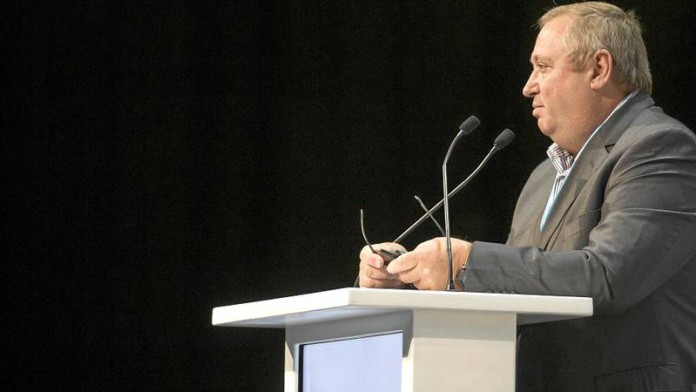
SIBANYE-Stillwater is considering plans to convert its ageing Beatrix West gold operation in South Africa’s Free State province into a uranium mine as part of a strategy to build meaningful production of the fuel.
Commenting in the precious metal firm’s financial results ended June 30 announcement today, in which it unveiled a R8.4bn interim dividend, Sibanye-Stillwater CEO, Neal Froneman said unlocking “latent value” by building uranium production would complement the firm’s green metals strategy.
“Beatrix West has substantial uranium resources and has potential to be converted into a uranium mine that is already largely developed as the mature gold resources deplete or become unviable,” he said.
Beatrix West was originally known as Oryx and was developed by Gencor in the Eighties at a then cost of R2.6bn in order to access the Beisa uranium deposit.
Froneman considered accessing the uranium deposit when running Sibanye-Stillwater forerunner, Sibanye Gold in 2013 before deciding not to press ahead. Froneman said today “not much uranium mining has taken place”.
Another option for uranium under consideration by Sibanye-Stillwater was to re-mine uranium tailings from the Cooke resource west of Johannesburg, a former gold mine, “… in a constructive price environment with interest in uranium as a clean energy source increasing globally,” he said.
Sibanye-Stillwater said there was a125 GW pipeline of new nuclear capacity under development which would put the uranium market into deficit in the next five to 10 years. The uranium price would average $60 per pound (lb) in the long-term.
The push into uranium would be managed by Sibanye-Stillwater’s long-standing associate and adviser, Dennis Tucker.
Quo vadis gold?
Sibanye-Stillwater wants to diversify in terms of minerals production and their locations. Since 2016, the company has become the largest primary producer and recycler of platinum group metals (PGMs), and recently added lithium and nickel assets to its portfolio – so-called battery minerals – with investments in Finland and France.
However, the company also said earlier this year it was interested in maintaining gold production – the metal on which Sibanye-Stillwater was founded. Gold production consists of just under one million ounces of South African output.
The company is thought to have made merger approaches earlier this year to Gold Fields and AngloGold Ashanti following sharp gains in Sibanye-Stillwater’s share price against AngloGold in particular. AngloGold and Gold Fields have the majority of their production in Africa, South America and Australia.
Froneman said today it was a “logical objective” to diversify the gold portfolio, but this goal would only be advanced if value could be delivered to shareholders. “Although relative valuations of the international gold companies have again improved, the residual value gap restrains progress.
“We will continue to review our position in the context of prospects for sustained gold price appreciation in a protracted low real yield economic climate,” he said.
Record earnings
Sibanye-Stillwater produced record numbers as expected largely owing to PGM prices which averaged R53,629 per 4E oz in the six month period (for its South African production). This compares to R33,375/oz for the interim period last year and R38,954/oz in the previous six month period to end December.
Combined with higher interim gold production year-on-year, and despite a slightly softer gold price, the outcome was R24.8bn in headline earnings, dwarfing the R9.4bn earned in the six months ended June in 2020, and beating even the R19.9bn in the six months ended December 30.
The performance was the basis for recent Sibanye-Stillwater announcements including a R9.6bn share buy-back programme, the early redemption of the R5bn, 2022 corporate bond, and R6bn in gold and PGM projects which were unveiled in the firm’s 2020 full-year results announcement in February.
The interim dividend was 35% of group profit representing the upper end (35%) of its 25% to 35% of normalised earnings dividend policy. Including the buy-back programme, a total return of R30bn will be booked, the company said.
Sibanye-Stillwater closed the six month period with net cash of R10.2bn ($712m).
Safety lapses
As previously flagged, there were significant recoveries in production year on year as the company emerged from Covid-19 related disruption.
However, Sibanye-Stillwater said the resumption of normal productive capacity also came with a worrying slip in safety levels.
A “concerning regression” in safety continued from last year into the first half of the current financial year, the company said today. There had been an improvement since July following “… an intensified focus on safety and wellbeing in order to re-energise the system and reemphasise critical safety protocols”.
Nevertheless, the damage was done in terms of production at Sibanye-Stillwater’s US operations, the original Stillwater Mining PGM 2E operations, which suffered a 21 day safety-related shutdown during the period. Instead of marking a recovery in production at the US mine, 2E PGM output in the first six months of this year unchanged at 298,301 oz owing to “extended safety related work stoppages”.
Sibanye-Stillwater forecast full year PGM output from its South African operations at between 1.75 to 1.85 million oz while 2E production from the US Stillwater mine would be between 620,000 and 650,000 oz. Gold production would be 884,000 and 948,000 oz.








